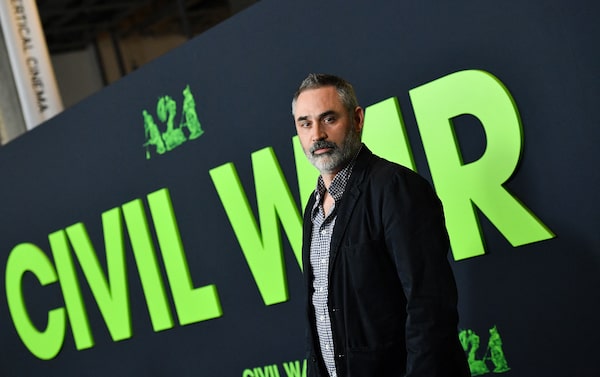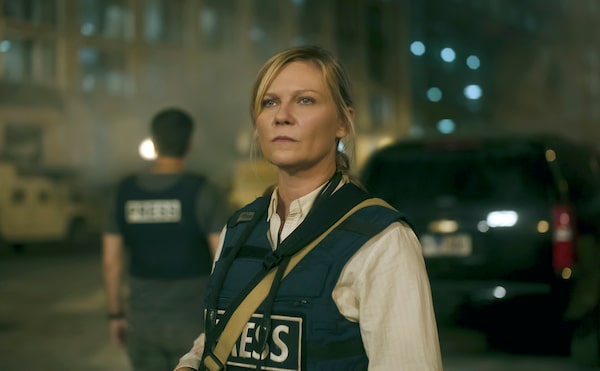
Filmmaker Alex Garland arrives for Civil War special screening at the Academy Museum of Motion Pictures in Los Angeles on April 2.VALERIE MACON/Getty Images
In Alex Garland’s future-set action film Civil War, a White House is under siege, a country is militaristically divided and the President spews propaganda. The story is a warning against extremism, but it is not just the stars-and-stripes nation that is at risk.
“Every country is subject to the danger,” says the British director who also wrote the chilling script. “Nobody is immune.” Garland spoke to The Globe and Mail from Los Angeles.
The tone of the film, on a number of levels, is harsh. It rattled me, in a good way. Was that the intent?
The film’s intent is to do different things. One is using the texture or the grammar of reality. It takes its cues from lived experiences or documentaries and news footage, rather than cinematic languages. Hopefully in some ways it is cinematic, but there’s stuff the film is deliberately not doing that belong to cinema.
Does that apply to the sound textures?
Yes. With the gunfire, for example, how we recorded it and how we presented it, we avoided things like adding tricksy sub-bass notes to amplify its effect. The starkness is more abrasive, and, in a way, more intimidating. Cinema has this funny way of being reassuring, in subtle ways, whilst being very dramatic. We took some of the reassuring subtleties out.
Actors Kirsten Dunst and Wagner Moura sought to understand how journalists cope with working in war zones as they prepared for their starring roles in the movie Civil War, which is released in U.S. cinemas on April 12.
Reuters
Reassuring, this film isn’t. Is it a wake-up call?
It would be a bit arrogant of me to say it was a wake-up call. The film comes out of anxieties, but we all know the anxieties and most of us share the anxieties. I think what the film does is compress and demonstrate the anxieties.
If not a wake-up call, what is it?
It’s really about two things. It’s about journalism and it is about social division and populist politics and polarization. And it says there is a logical extension to the division, and the logical extension is civil war. It’s about the erosion of checks and balances and the erosion of the fourth estate – the things that guard you against extremism. This film is what that looks like in some respects.
The New York Times reporter played by Stephen McKinley Henderson is broken down and on his last legs. Is that a metaphor for legacy media?
The whole thing is about legacy media in some respects. Including the youngest of the journalists, who is using a 35 mm camera, which is a nod to combat photographers such as Don McCullin and many, many others. It is presenting generations of journalists, but they are functioning as reporters.

Kirsten Dunst plays a photojournalist.The Associated Press
Kirsten Dunst’s photojournalist character is particularly dispassionate.
I’m middle-aged. Journalism had a different flavour when I was younger. It had an attempt in news reporting to deliberately remove bias. What reporters would do is present a sequence of events. It’s more nuanced than that, of course. Any journalist has bias, but there is a sliding scale.
The difference is that journalists today are being cast as the enemy.
Yes, and by various means. Sometimes it’s external, by politicians deliberately attempting to undermine journalism, and by having it co-exist with social media, which clearly is a strong environment. And also internally, by large news organizations really embracing bias. All the journalists in the film are a throwback, in one way or another. The film itself is trying to echo that by functioning as a reporter itself.
There is a mistrust of media today. Will people trust this film? How do you think MAGA enthusiasts will react to it?
I don’t know. But what I would do is differentiate between different kinds of things. Things get conflated, and I’m not sure the conflation is accurate. There’s the way people behave with each other as individuals in their life, and often it is pretty courteous and thoughtful and respectful and conversational. And then there is something that sits over that, which has to do with public discourse. And that has extremism built into it – a kind of slightly hysterical, frenzied quality.
What’s the correlation between those two things?
I’m never completely sure. My gut feeling, and I could be wrong, is that we have made outliers feel as if they are the dominant voice. Most people are not in the same place as those outliers. As individuals, people tend to be more sophisticated and more nuanced. The differences are exaggerated.
But the differences are real, aren’t they?
There is a polarized state. There is division. How much of that division is real and how much of it is felt, they may be two slightly different things. It’s not that I know the answer to that. I don’t.
The film is often described as being set in a dystopian future, but couldn’t we see it as being ripped from the headlines?
That’s exactly right. It is sort of ripped from the headlines. If I were to think of dystopia, I would think of Mad Max. This is closer than that. Countries are undermining a system of checks and balances, either with the government or with the media, which is there to hold the government to account. What is happening is the removal of a guard – a really, really important guard. And the guard is against crazy extremism. That doesn’t feel dystopian to me. It feels dangerous.
This interview has been edited and condensed.